My love of coffee comes from my mother.
For her, having Turkish coffee was almost a daily ritual that had to be done with friends and family. More than anything, it was a way to celebrate her friendships and show gratitude to the ones she loved.
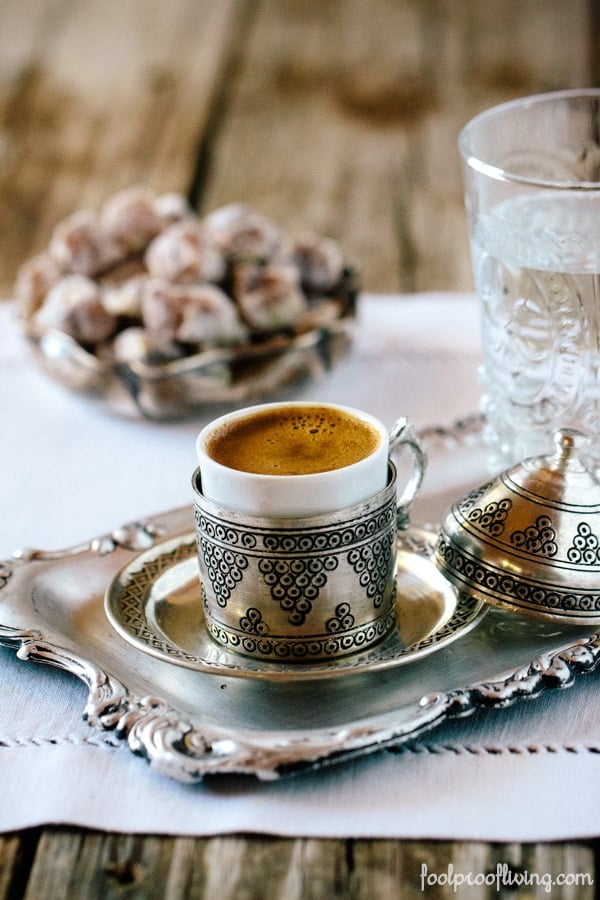
Though she worked most of her life, on those rare days when she was home, she would invite her friends over for coffee in the morning. Prior to their arrival, she would make me set up two trays: the first one with Turkish coffee cups and the second one with water glasses. We would always have something sweet to serve the coffee with. Although Turkish delights are more traditional, my mother loved serving hers with chocolate.
When her friends would arrive, it was my job to make and serve the coffee. After welcoming them, I would ask how they take their coffee and then immediately go to the kitchen to make it to their liking. It was such a proud moment for my mother when I would come out of the kitchen with the tray in my hand.
When I look back and think about it today, I realize how important it was for her that I understood the tradition behind it. I was very fortunate that I was allowed to drink coffee at a young age and learn to enjoy it through the family tradition.
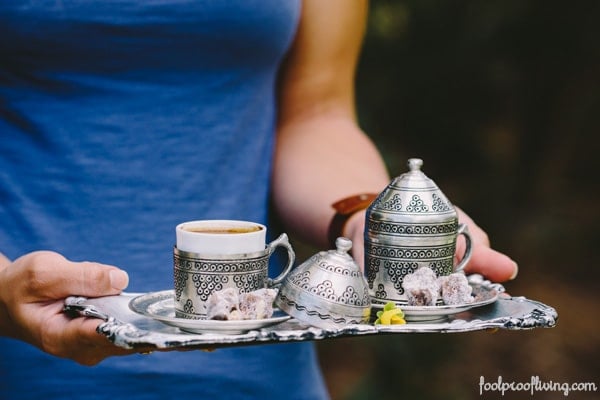
In Turkey, when you go to somebody’s house, the first question isn’t if you want to drink Turkish coffee, but rather how you would like to have your coffee prepared. By how, your host is asking about the amount of sugar you would like to have in your coffee. To answer the question, you may say “sade” which means no sugar; “az seker” which means very little sugar; “orta” which means with 1-2 teaspoons of sugar; or “sekerli” which means with 3-4 teaspoon sugar.
Once you place your request, it is the responsibility of the person making the coffee to prepare it according to everyone’s individual sugar preferences. Usually, that person is the youngest girl of the house. As you can imagine, as the only daughter of our household, I’ve made more than my fair share of coffee in my lifetime. Therefore, I feel qualified enough to share my knowledge with you.
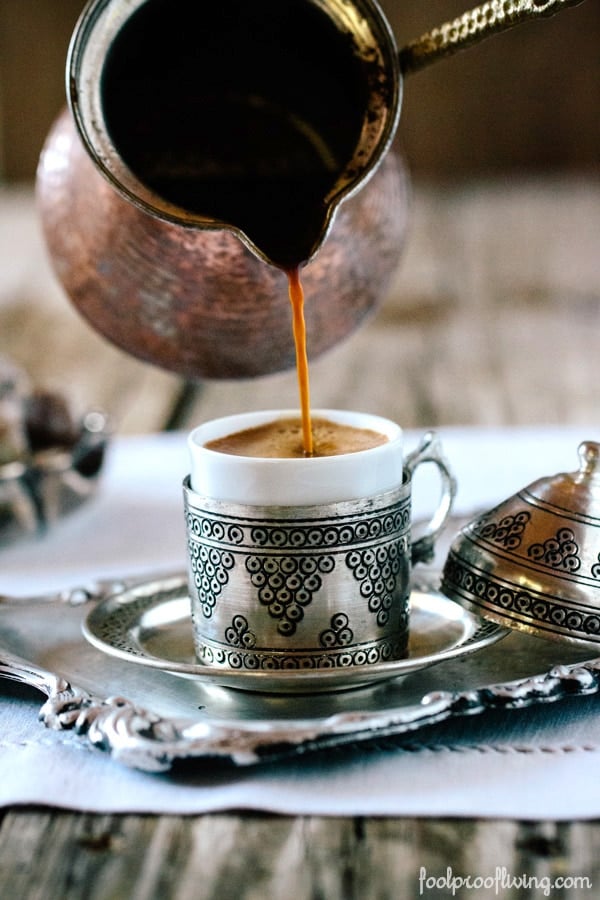
Ingredients You Need:
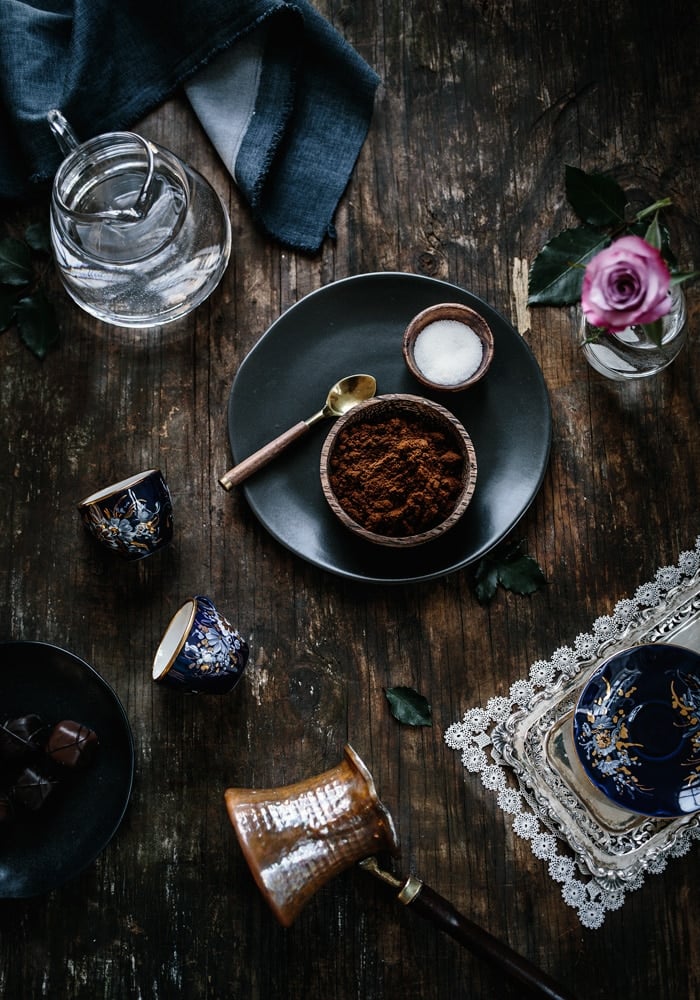
You will need:
- Cold filtered water
- Turkish coffee: Turkish coffee is much more finely ground than regular coffee. Even though you can grind it yourself, nowadays you can find it in most Middle Eastern or Mediterranean supermarkets. My favorite brand is Kurukahveci Mehmet Efendi (affiliate link).
- Cezve (a special wide-bottomed pot, usually made of copper) I have one similar to this Copper Turkish Coffee Pot (affiliate link) and have been using it for years.
- Turkish coffee cups: Here is a set (affiliate link) you can purchase
- Granulated sugar
How to Make Turkish Coffee
Making Turkish coffee is easy and requires no special skills, so long as you know a couple of tricks.
Here is how in a nutshell:
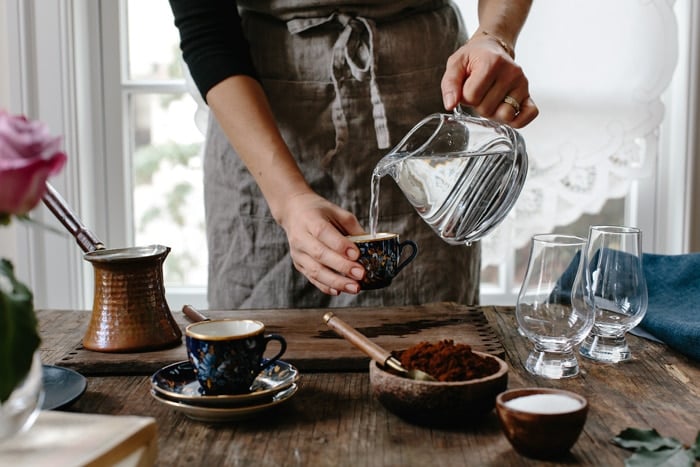

- Water: Always use cold, filtered water. To measure the amount of water for each cup, use the coffee cup you are going to use.
When it comes to the water to Turkish coffee proportions my rule of thumb is 1½ “cup” of water per cup. Once again, the “cup” measurement is the coffee cup that you are going to serve the coffee in, rather than a standard measuring cup.
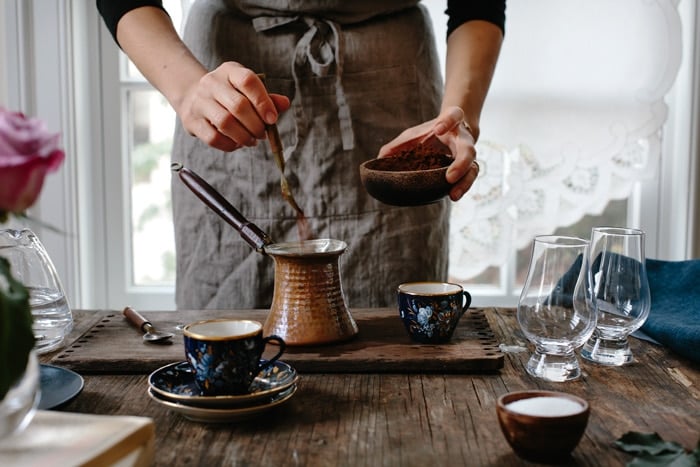
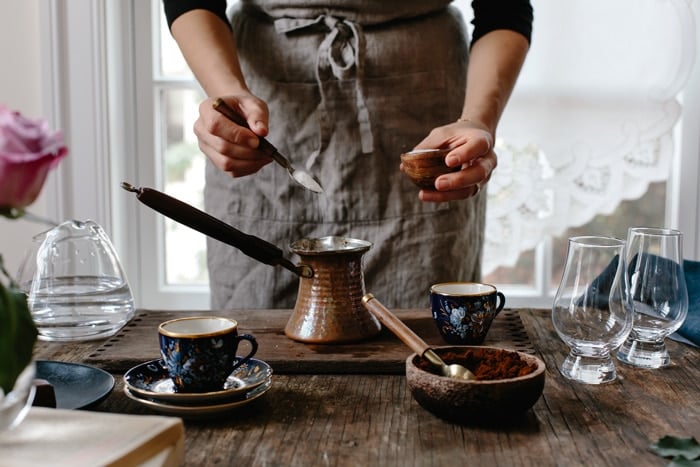
- Coffee & Sugar: For each cup of coffee, use a heaping tablespoon of ground coffee. If preparing a cup with sugar, add it in the very beginning, stirring the mixture until combined. However, if one or more of the guests prefer no sugar, prepare and pour that cup first. After returning the coffee pot to the stove, add in more sugar to suit the preferences of the remaining guests.
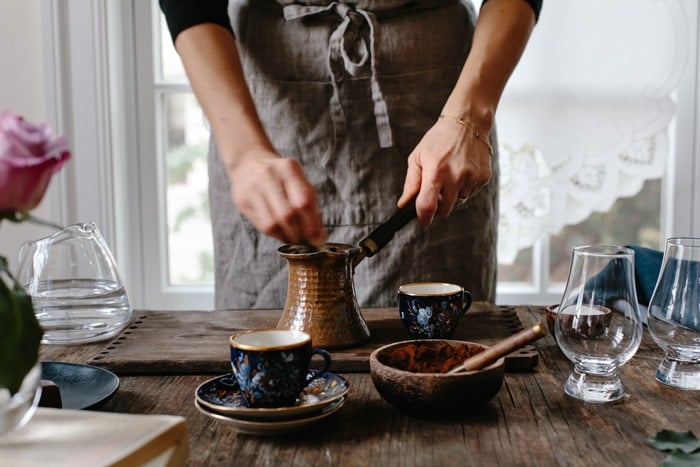
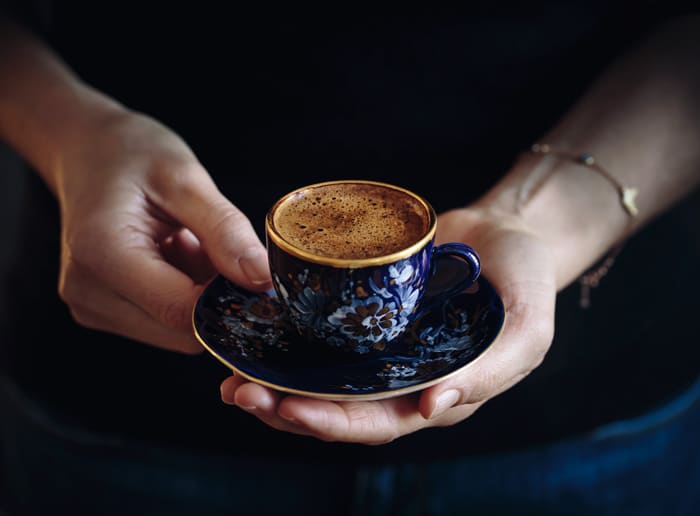
How To Cook Turkish Coffee
Slowly bring the mixture to a boil over medium heat. This will take 3-4 minutes, so keep a close eye on it. As the coffee warms, a dark foam will build.
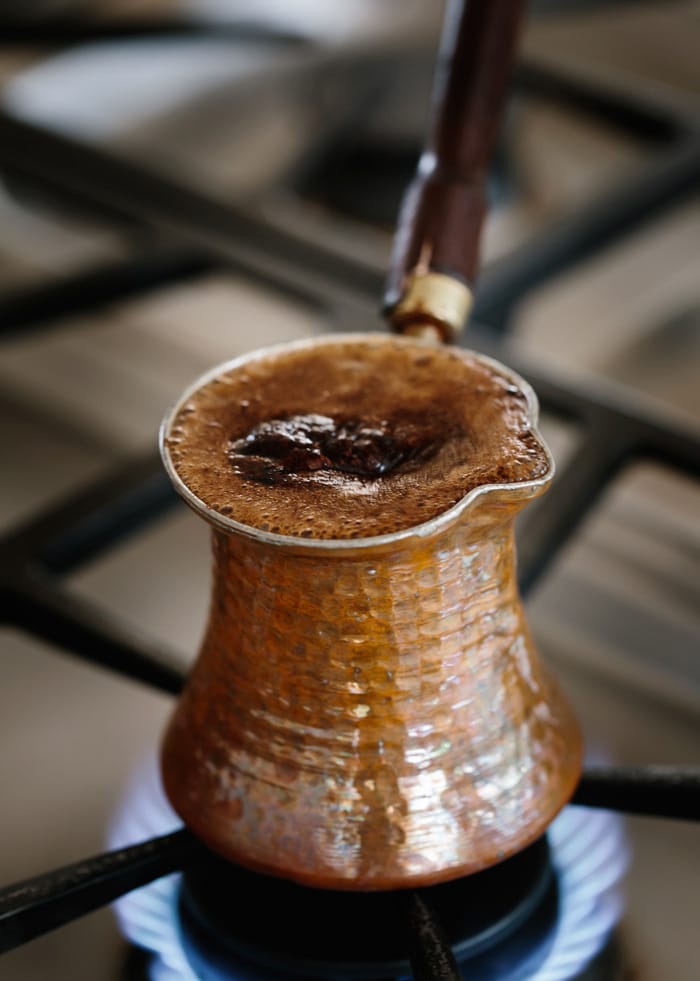
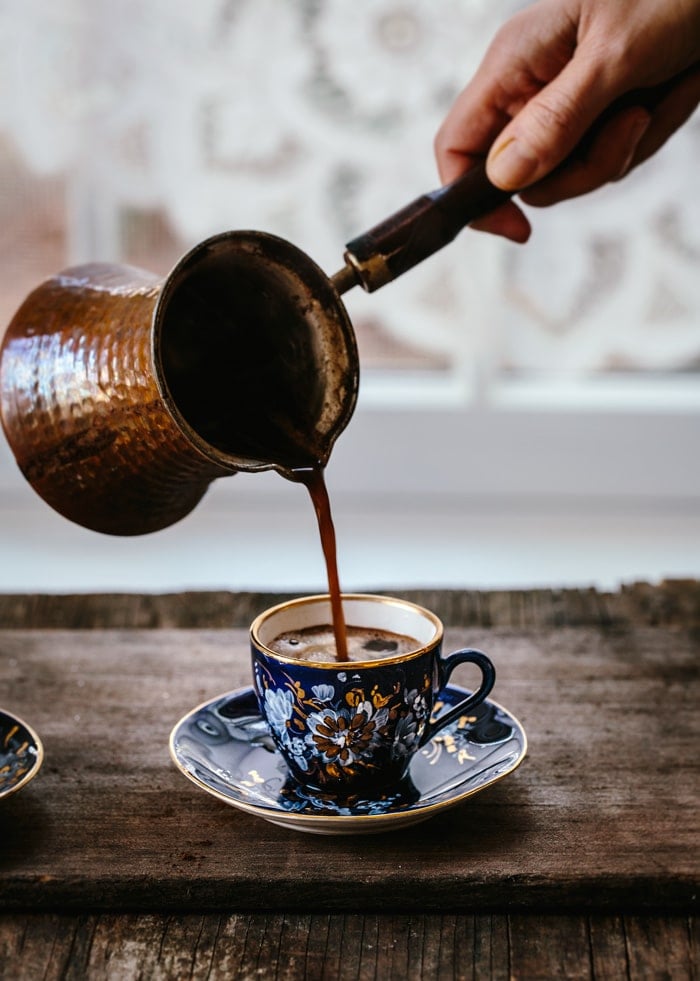
It is customary and important to serve Turkish coffee with foam on top. When the mixture is close to a boil, use a teaspoon to transfer some of the foam into each coffee cup. Return the coffee pot to the stovetop.
As coffee comes to a boil, pour half of the coffee into the cups, over the foam. Return coffee pot to stovetop and boil the remaining coffee for an additional 10-15 seconds and fill the cups to the rim.
How To Serve:
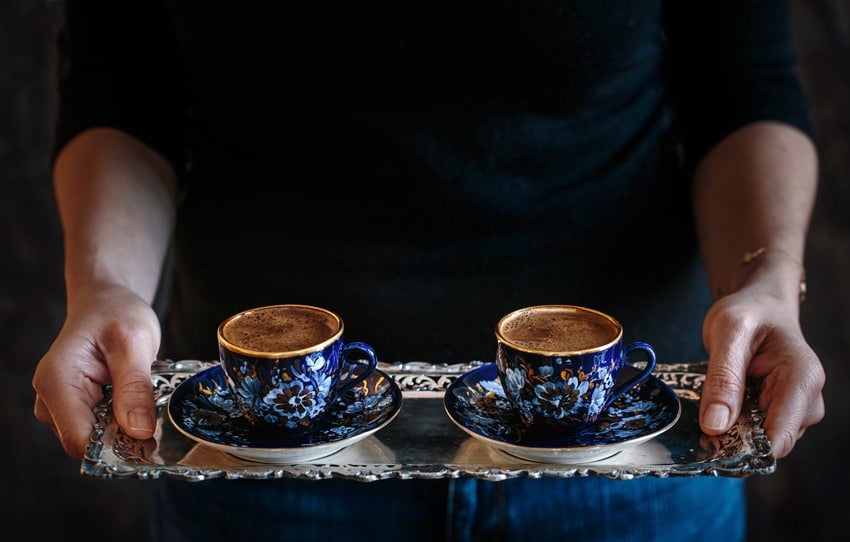
To serve:
- We always serve Turkish coffee with cold (or room temperature) water, because a sip of water will allow the person to clear his/her palate before drinking coffee for the best enjoyment. In addition to water, most people like to serve it with a small sweet treat like Turkish delights, chocolate, candy, etc.
- When serving it is important to start with the eldest guest in the room. It is a sign of respect to acknowledge their age and considered disrespectful not to do so.
- Since this type of coffee is much denser than filtered coffee, it is not customary to drink more than one cup. I have read on some websites that some people add milk or cream to their coffee, but to be honest, I have never seen anyone in Turkey add milk or cream to their Turkish coffee.
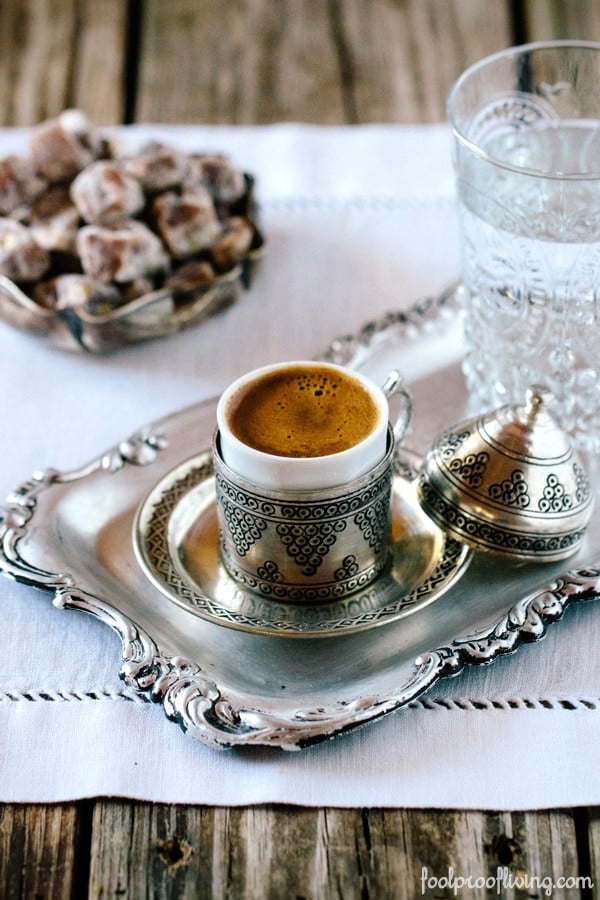
Almost eight years after her passing, when I close my eyes and think about my mother today, I picture her with a Turkish coffee cup in her hand, telling stories of whatever is happening on that particular day. Though I want to continue our family tradition every opportunity I get, I know it will never be the same without her.

Frequently Asked Questions:
What kind of coffee/roast should I buy to make Turkish Coffee?
I have a few readers asked me if Starbucks’ coffees would work if they were to ask the barista to grind it as Turkish coffee. To be quite honest, I have never tried this, but I do not think so. What I know for sure (and the one I recommend) is Kurukahveci Mehmet Efendi (affiliate link). This is the coffee that I use (and grew up drinking) when I make my Turkish coffee.
Do I need that special pot (cezve or ibrik) to make Turkish coffee?
The answer is, it depends. I recommend getting it as (1) it is a tradition to cook Turkish coffee in a cezve and (2) cooking it in a cezve will give you the thick foam (more in this below) on top. With that being said, if you are not concerned with those two things, you can make our coffee in a very small saucepan.
I have one similar to this Copper Turkish Coffee Pot (affiliate link) and have been using it for years.
How do you get that thick foam on top?
This is a much-debated subject and you might get different answers if you asked different people. Below steps were what my mother taught me:
- Once you mix water, coffee and sugar (if using), give it a quick mix but do not overmix it. Since you are cooking it in a very small pot (cezve), as it boils it will mix itself. I know that it is very tempting to want to mix it but resist the urge.
- Once you pour your first pour, then you can give it a mix because the thick foamy part should already be in the cup.
- As you pour your second, be sure to pour very slowly to not break the foam.
What if I am making Turkish coffee for multiple people with different sugar preferences?
If this is the case, you can do one of two things. First, you can make them in different pots, but for that, you would have to have more than one cezve.
Second, you can start making it with no sugar, pour the first pour to all the cups and then add in the sugar in the second pour.
For example: Let’s say I making Turkish coffee for 2 of my guests. First, start with the person who wants his sade (with no sugar) and then continue with the second person who wants his orta (1-2 teaspoon sugar). Below are the steps I would follow to make them at the same time in one pot (cezve):
- Start by cooking water and coffee for 2 servings with no added sugar
- Pour your first pour halfway into two coffee pots.
- Boil the second pour and fill up the first serving with no sugar.
- Then add in sugar into the pot, mix it, and bring it to a boil before you top off the second serving. Since Turkish coffee is pretty thick and served in such a small cup, it will have enough sweetness.
Where did you get the blue cups in the photos?
I borrowed those cups from a friend of mine. They were a gift to her from her husband. He purchased them from Pasabahce many years ago. I am not sure if they are still selling them, but since this was asked more than once I thought I can answer it here.
Where can I find Turkish Coffee cups?
If you ever visit Turkey and most other nearby countries, you can find a variety of options for Turkish coffee cups. However, if that is not possible you can easily find them online. Additionally, you can use espresso cups. They are a little larger but they would do the job.
Here is a set (affiliate link) you can use to make both types of coffees.
What is Turkish Coffee reading (fortune-telling)? Do you believe it?
It is a tradition that after you finish your coffee, you turn your cup upside down and let it cool down so that someone else can “read your cup”. This is a fun tradition, where someone (who is talented enough to make up stuff) looks into the cup and tries to guess your future based on the shapes of the coffee’s residue that stuck on the walls of your cup. If you are a believer of this kind of stuff, it could be quite entertaining.
My mom was one of those people, who would read people’s cups just for the fun of it. I no longer believe in such readings, but when I was a teenager and was falling in love with a different guy every week, I remember drinking a lot of Turkish coffee and begging her to read my cup to see if “my new found love” is going to ask me out any time soon. 🙂

How to Make Turkish Coffee At Home
Ingredients
- 3 Turkish coffee cup-sized cups of cold filtered water, 1 1/2 cup per cup
- 2 heaping tablespoons Turkish Coffee, ground
- Sugar – as requested
Instructions
- Place the sugar (if desired), water, and Turkish coffee in metal Turkish coffee pot (Cezve).
- Using a small spoon, stir briefly until just combined and place pot on stovetop.
- Slowly bring coffee mixture to a boil over medium heat. This will take 3-4 minutes, so keep a close watch.
- As the coffee warms, you will see a dark foam building up. Closer to it coming to a boil, using a teaspoon, transfer some of the foam into each of your two Turkish coffee cups. Return coffee pot to stovetop.
- As coffee comes to a boil, pour half of the coffee into the cups, over the foam.
- Return coffee pot to stovetop and boil the remaining coffee for an additional 15-20 seconds and pour the rest in to the coffee cups to the rim.
- Serve with water and Turkish delight.
Video
Notes
What if I am making Turkish coffee for multiple people with different sugar preferences?
If this is the case, you can do one of two things. First, you can make them in different pots, but for that, you would have to have more than one cezve. Second, you can start making it with no sugar, pour the first pour to all the cups and then add in the sugar in the second pour. For example: Let’s say I making Turkish coffee for 2 of my guests. First, start with the person who wants his sade (with no sugar) and then continue with the second person who wants his orta (1-2 teaspoon sugar). Below are the steps I would follow to make them at the same time in one pot (cezve):- Start by cooking water and coffee for 2 servings with no added sugar
- Pour your first pour halfway into two coffee pots.
- Boil the second pour and fill up the first serving with no sugar.
- Then add in sugar into the pot, mix it, and bring it to a boil before you top off the second serving. Since Turkish coffee is pretty thick and served in such a small cup, it will have enough sweetness.
Nutrition
Nutrition information is automatically calculated, so should only be used as an approximation.
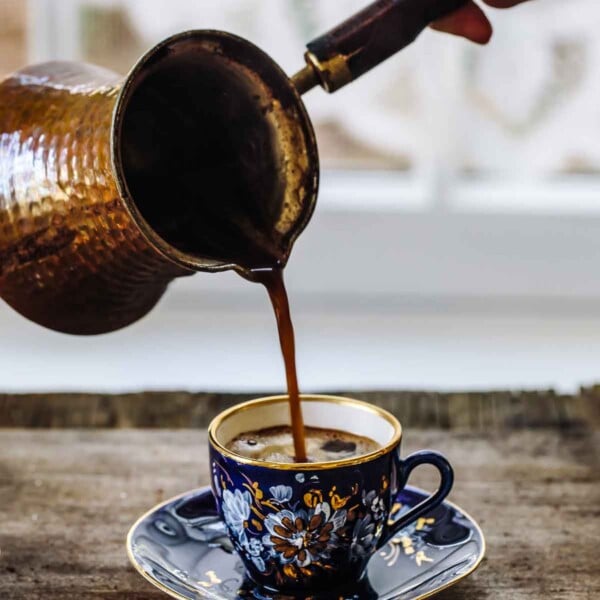
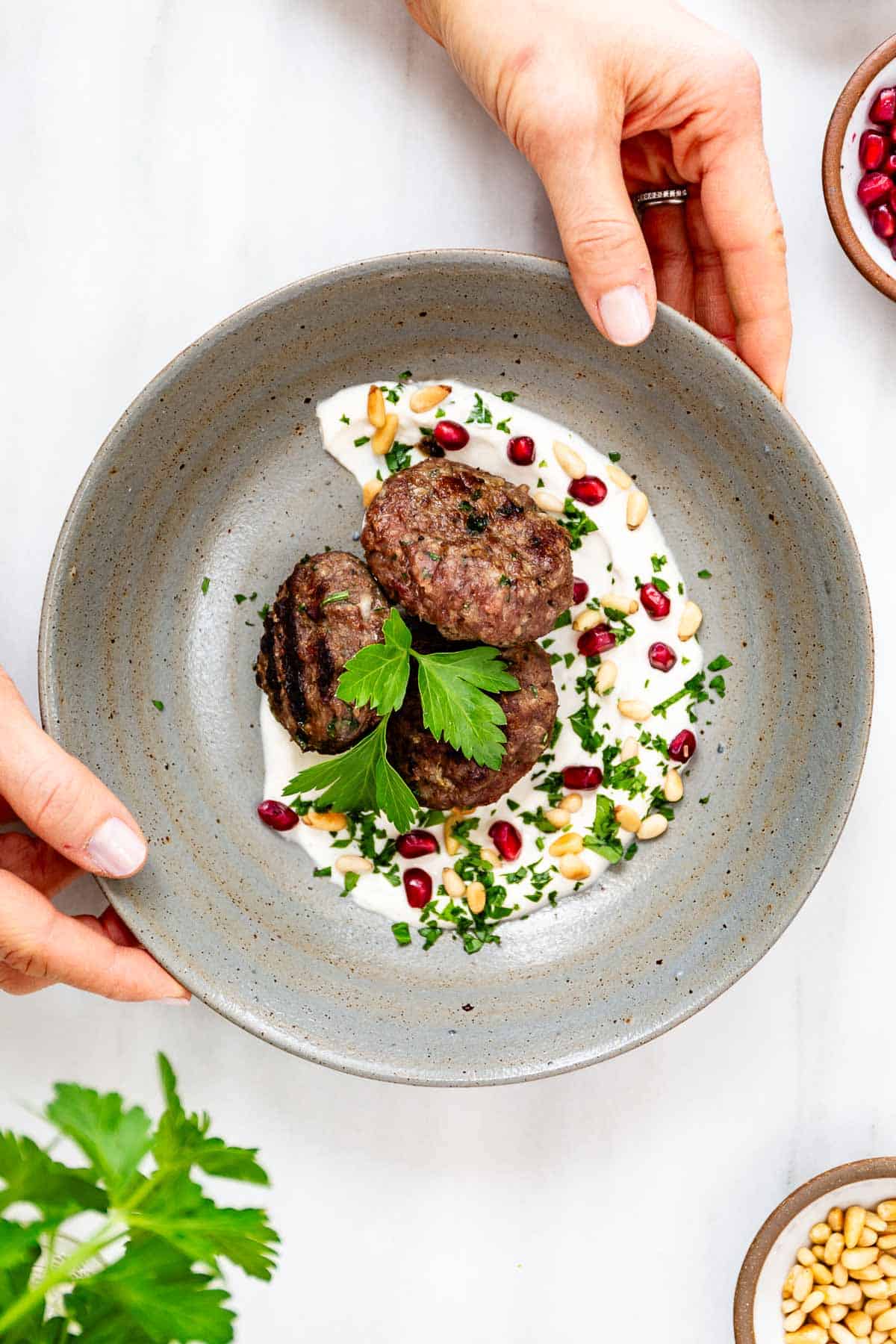
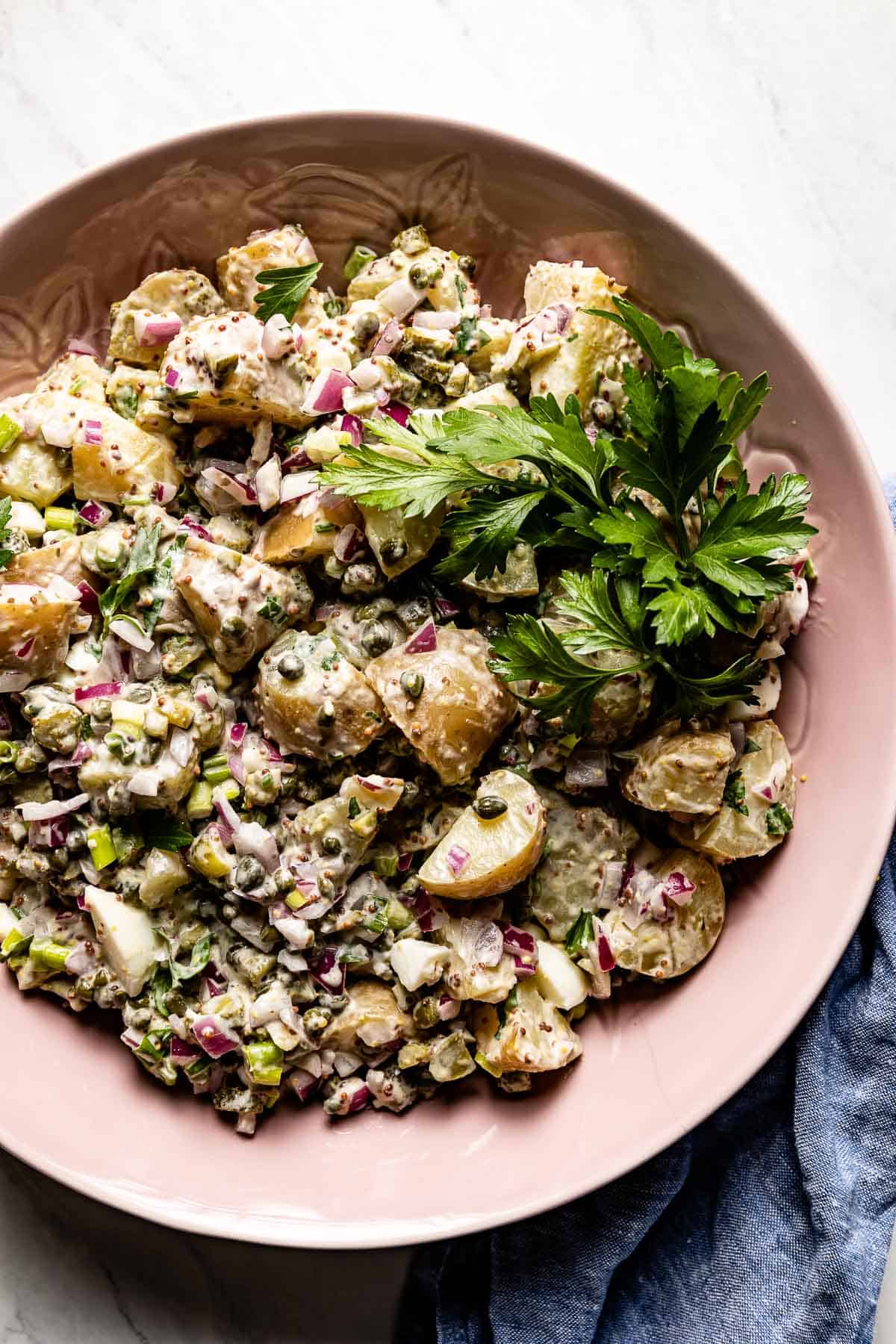

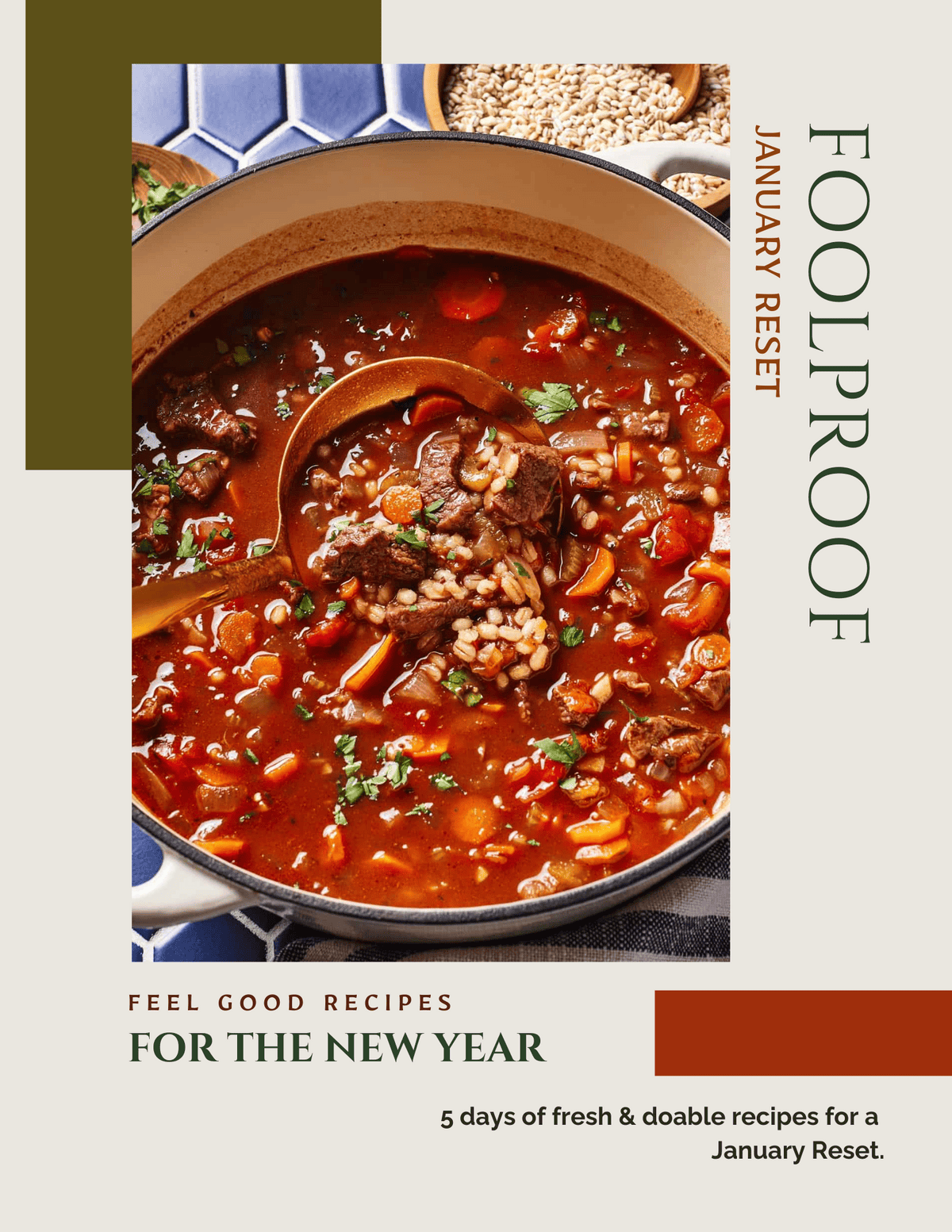









Phenomenal recipe and story. Thank you!
Thank you Michael.
Thank you… clear concise and good visuals.
Everyone – try this coffee, as it’s a lively and lovely break from “standard” north American fare. Although it results in a brew not unlike an thicker version of espresso or Moka pot coffee, you will however detect a measurable differing note, which i suspect is simply due to method of brewing.
I am glad to hear that you liked it Mare. Thanks for coming by and taking the time to leave a review.
Turkish coffee amazing, just like Istanbul.
I cannot agree more 🙂
wonderful ! Thank you so much for this delicious cultural eye opener ! I am in Canada & very Canadian
You are welcome Dianne.
Thank you for this wonderful post about making Turkish Coffee Mrs. Aysegul! , my name is Johan, and I went for the First time to Istanbul, which was an unforgettable experience, I brought home Turkish coffee, and a set, also… my all time favorite, Turkish Delight!
Kind regards
Johan
I am happy to hear that this recipe resonated with you Johan. Thanks for coming by.
Hi there, dear ice
I’m happy to read about your memories of Mom and yourself, and I really like your recipes.
I learned to love the virtues and fine flavors of Turkish food in my 4 visits to Turkey.
You make coffee almost exactly as my late father would. He was a construction worker, and all the people who worked with him loved his coffee.
Dad used a steel jug like yours, the same ratios of water and coffee.
But when the boiling began, he would lower the flame and watch the foam rising around, and when it almost reached to the center of the jug he would turn off the gas and pour like you, a little for each cup and afterwards to fill.
When I served in Isral air force I used to make my coffee every day in the morning for myself and friends who loved it.
Thank you!
Dear Ice,
I was enchanted with this post. I don’t drink coffee but have often wondered about it and the ritual that goes with it. Have always loved all of the copper utensils used in Turkey.
Nice to have those memories.
Big hug,
Susan
I am happy to hear that Susan. Thanks for coming by.
At nearly 55 years old I am finally making and trying Turkish coffee and was pleasantly surprised at how much I love it, especially without cream. Thank you for the education and for sharing your history. You were certainly blessed with your mother.
I have a question about the cezve. I see that you use a copper pot. Does copper make an ideal choice for making Turkish coffee? And why? Because of the way the liquid reacts with copper? Right now I am using an electric stainless steel pot which makes it easier to make. However, later on when I find my own taste preferences and settle on making it a tradition for myself, I am wondering if I should also invest in a copper cezve like the one you shared in your link.
Pauline,
I am so happy to hear that you enjoyed this recipe and are now a big fan. To answer your question:
First of all, please know that the copper pot I am using here is lined with stainless steel. So, technically the coffee is not cooking in copper. I am pretty sure you already know that but I wanted to mention. Secondly, copper is a great conductor of heat, which is crucial for the preparation of Turkish coffee. And since Turkish coffee needs to be brewed at a precise temperature (just below boiling), the high thermal conductivity of copper also provides greater control over the temperature. Finally, it is traditional to cook Turkish coffee in a copper cezve.
With all this being said, you can cook Turkish coffee in a stainless steel cezve. If you watch the video in the recipe card, you can see the ones I use/own.
I hope this answers your question. Please let me know if I can help in any other way.
Thanks for coming by and taking the time to share your experience.
Aysegul